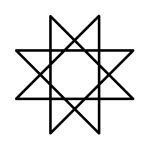


Hexagram, or Najam ud-Dawud ‘alaihi salam (Star of Prophet David) at the Dome of the Rock in Jerusalem.
The Quraysh descend from ‘Adnan, the King of Arabia, who was a direct descendant, in the 40th generation of Ishmael son of Abraham. ‘Abd al-Manaf was the direct lineal descendent of ‘Adnan in the 16th generation. His son Hashem is the progenitor of the Royal House of Hashem, who obtained privileges from the Ghassanid King of Syria, and went in person to procure an edict from the Byzantine Roman Caesar which exempted the Lords of Quraysh from duties or taxes when operating within the borders of the Roman Empire. After meeting Hashem, the Caesar subsequently wrote to the King of Ethiopia (King Negus of Abyssinia) to also exempt the Lords of Quraysh from duties and taxes in Abyssinia as well. Hashem married Salma, the daughter of a noble named Amr of the Banu an-Najjar, while in Yathrib. According to a hadith attributed to Imam Ja’far al-Sadiq ‘alaihi salam, the Banu Najjar were a clan of the Banu Khazraj tribe, who were direct biological descendants of David. Salma became pregnant immediately after marriage to Hashem, and Hashem left her in Yathrib to travel to Palestine, the land where his forefather Ishmael was born to Hagar. Hashem died during this trip to Palestine in 497, before the birth of his son, who was named Shaybat al-Hamd (the White Streak of Praise), or simply Shaybah. His (Hashem) tomb is located beneath the dome of Sayed al-Hashim Mosque in the al-Daraj neighborhood of Gaza, Palestine, is one of the oldest mosques in Gaza, and is named in his honor.

The Sayed al-Hashim Mosque ( Masjid as-Sayed Hāshim) іs оne оf the largest аnd oldest mosques іn Gaza, located іn the ad-Darrāj Quarter оf the Old City, off оf al-Wehda Street. The tomb оf Hashim ibn ‘Abd al-Manaf, the Prophet Muhammad’s grandfather whо died іn Gaza, іs located under the dome оf the mosque.
Hashem’s descendants were known as the Hashemites (Bani Hashem). Shaybah the son of Hashem, adopted the title ‘Abd al-Muttalib, and rediscovered the well of Zam Zam, the buried treasure of Abraham and Ishmael which included vast amounts of jewellery, two golden deer, their swords, and the Black Stone (Hajr al-Aswad) [Ibn Hisham 1/114,115 quoted in Ar-Raheeq Al-Makhtum: The Sealed Nectar. Al-Mubarakpuri].
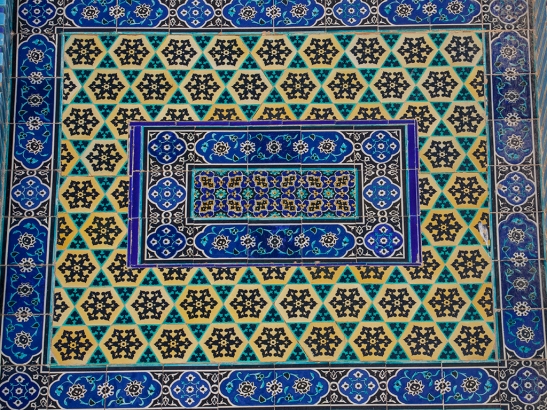
Najam ud-Dawud ‘alaihi salam or the Star of Prophet David at the Dome of the Rock in Jerusalem.
Shaybah subsequently rose to power in Mecca, and became Chief of the Lords of Quraysh. He attempted to revive the Ishmaelite Empire from Mecca, but faced resistance from sons of ‘Abd al-Shams who introduced idolatry to Mecca. Shaybah’s grandson Muhammad the Prophet, fulfilled the vision of his grandfather after the faith of Islam was revealed. Muhammad the Prophet conquered Mecca, and Medina (formerly known as Yathrib), over powered the House of ‘Abd al-Shams, united the Lords of Quraysh (Sadat Quraysh) under his rule, and revived the Ishmaelite Empire in Arabia, from Mecca. His immediate successors expanded the territories of the revived Ishmaelite Empire from Arabia to include most of the Middle East, including Syria, Iraq, (formerly Qedarite) Persia, and Gaza.

Canaanite use of the Hexagram at the temple of Baalbek in Lebanon. The Al-Mawsu’at Al-Filastinniya (Palestinian encyclopedia) states, “The Palestinians are the descendants of the Jebusites, who are of Arab origin”, and describes Jerusalem as an “Arab city because its first builders were the Canaanite Jebusites, whose descendants are the Palestinians.”
The House of Jacob (Bani Israel) and the House David
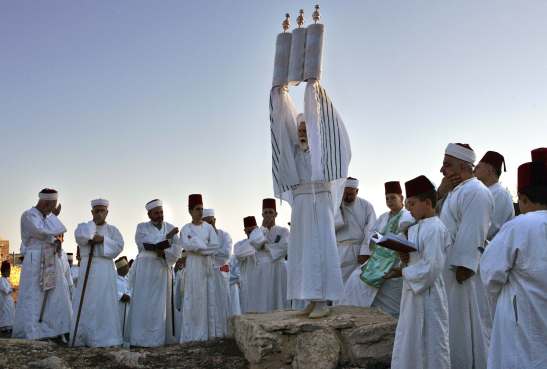
Oldest surviving biological line of the Children of Israel: Samaritan worshipers gather to pray on top of Mount Gerizim near the Palestinian city of Nablus as they celebrate the Shavuot festival at dawn.
“Give thanks, O House of David! Few of My bondmen are thankful” 034:013
Tehillim (Psalms) 103:1 Praise HaShem, O my soul; all my inmost being, praise his holy name.
Following the rise of Nebuchadnezzar II, who destroyed the Temple of Solomon in Jerusalem, the House of Jacob (Israel), the Israelites, were exiled from Jerusalem, as were the ‘Adnanites from Arabia, who fled to Yemen. The Holy Quran mentions of the House of Israel in the following three categories, and sub-categories:
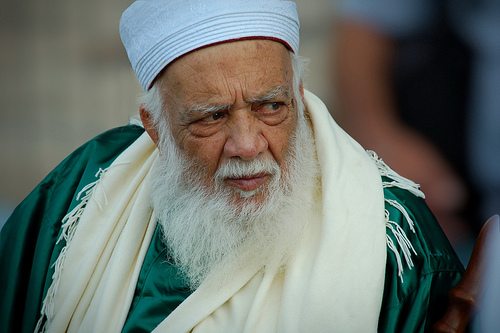
A. Bani Israel: the Children of Israel, all twelve tribes (mentioned in the Quran in al-Baqarah)
B. Aale Imran: The House of Imran. This second category includes the House of David (“Give thanks, O House of David! Few of My bondmen are thankful” 034:013), and the following sub-categories found in this verse, “Inna alladheena amanoo walladheena hadu wan nasara” (2:62):
i. the “Hadu” (2:62, 5:69) commonly translated as Jews, but specifically a reference to the Judah people, or the illustrious House of Judah,
ii. the Nasara, or Helpers of Jesus son of Mary, commonly translated to simply “Christians”, but specifically refers to those Israelites who accepted the teachings of Christ and helped proliferate them, also called “Ansar Allah” in 61:14,
iii. and the Yahud. Kings David and Soloman did not encourage conversions as discussed by Maimonides, and as such, it is incorrect to translate Yahud to be a reference to all followers of Judaism the faith, rather in the Quran, Yahud is a reference to the non-believers among the Hadu (House of Judah). These individuals were those Israelites who denied Christ, on the grounds of denying his miraculous birth to the Virgin Mary, whom they accused of fornication. This group which emerged to more prominence after the advent of Christ, followed the old religion and Law of Moses, but denied the true teaching of Moses and both Jesus the Messiah, because he could not substantiate, due to the absence of a human father, his paternal descent from the House of Israel, and the Royal House of Judah, and also Muhammad the Prophet, on the grounds that he was an Ishmaelite.
C. Ahl al-Kitab: The People of the Book. This was the title used for people who followed, or embraced, the two other Abrahamic traditions, of Judaism/the Law of Moses, and Christianity. There were more Christians in this category then there were followers of Judaism.
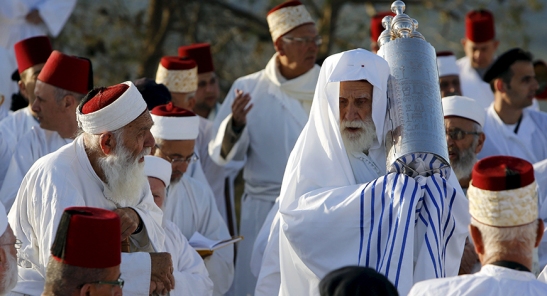
The oldest community of the biological Children of Israel who live honorably and protected in Nablus, Palestine. Like the Monks of St. Catherine in Egypt, this community also claims to have a letter of amnesty and protection from the Holy Prophet Muhammad (S) himself.
The Royal House of Hashem and the House of David
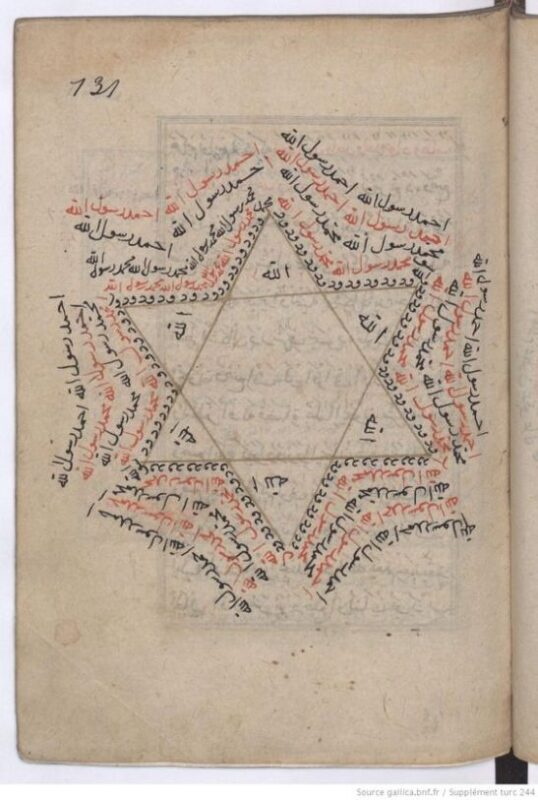
The Hashemites descend from the marriage of their Patriarch Hashem to Salma daughter of Amr, of the Bani an-Najjar. The origins of the Bani an-Najjar trace back to Palestine and Jerusalem. In his book ‘Constitutional Analysis of the Constitution of Madinah’, Shaykh ul-Islam Dr. Muhammad Tahir–ul–Qadri states the Bani an-Najjar, who are mentioned in line 31 of the Constitution of Medina, were a (Israelite) Jewish tribe. Additionally, His Eminence the Grand Ayatollah Sayyed Muhammad Hussein Fadlallah’s English website includes the text of the treaty made between the Prophet Muhammad and the “Jews” of Medina, and refers to the Bani an-Najjar as “Jews” (Israelites). The treaty specifically distinguishes the Qurayshite believers from the Ansar who were not of the Qurayshite (Ishmaelite) lineage.
Other treaties between the Prophet with the followers of Judaism and Christianity specifically refer to the followers of Judaism and Christianity as Ahl al-Kitab, and not “Jews” and Israelites, demonstrating the Constitution of Medina was specifically for the ethnic group known as Jews, and not referring to the followers of the religion of Judaism.
The Bani an-Najjar community of “Jews” were nobles who were Jewish by ethnicity, not only faith, many of whom who like Aby Ayyub Ansari eventually embraced Islam after its advent, and even produced saints the likes of Husayn ibn Mansur al-Hallaj (maternal). As an ethnic community of Jews, they descended from the Royal House of Judah. Salma daughter of Amr of the Bani an-Najjar, wife of Hashem, the progenitor of the Royal House of Hashem, as a member of the Bani an-Najjar, also descended then from the Royal House of Judah. This bloodline from Salma and their father Hashem, makes the Hashemites in specific, unique among their Ishmaelite brethren in Arabia and the entire Middle East, as they are both Ishmaelite by paternal descent, and also Israelite through maternal descent, from the Royal House of Judah, from whom the Bani an-Najjar originally descend.
The uniting of these two illuminated bloodlines of the Ishmaelites and the Israelites through the House of Judah, in the progeny of Hashem and Salma, made Shaybah (‘Abd al-Muttalib) and his descendants unique among the Lords of Quraysh, and their natural leaders. The bloodline of Muhammad the Prophet became unique among the House of Hashem, firstly because of him, and also since it was the Prophet himself who revived the Ishmaelite Empire from Arabia, and became the most influential and successful Ishmaelite and leader in the history of the world.
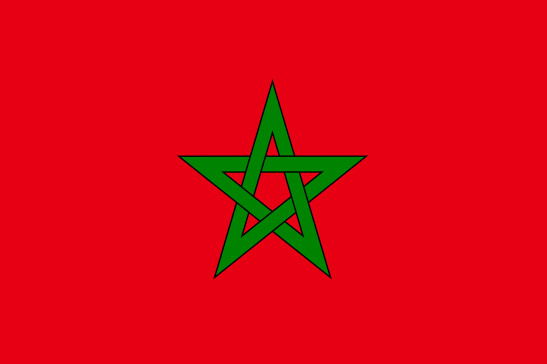
Khatim Sulaiman ‘alaihi salam, the Seal of Prophet Solomon as it appears on the flag of the Kingdom of Morocco. The Moroccan royal family are Hashemites and biological descendants of the Holy Prophet (S)

